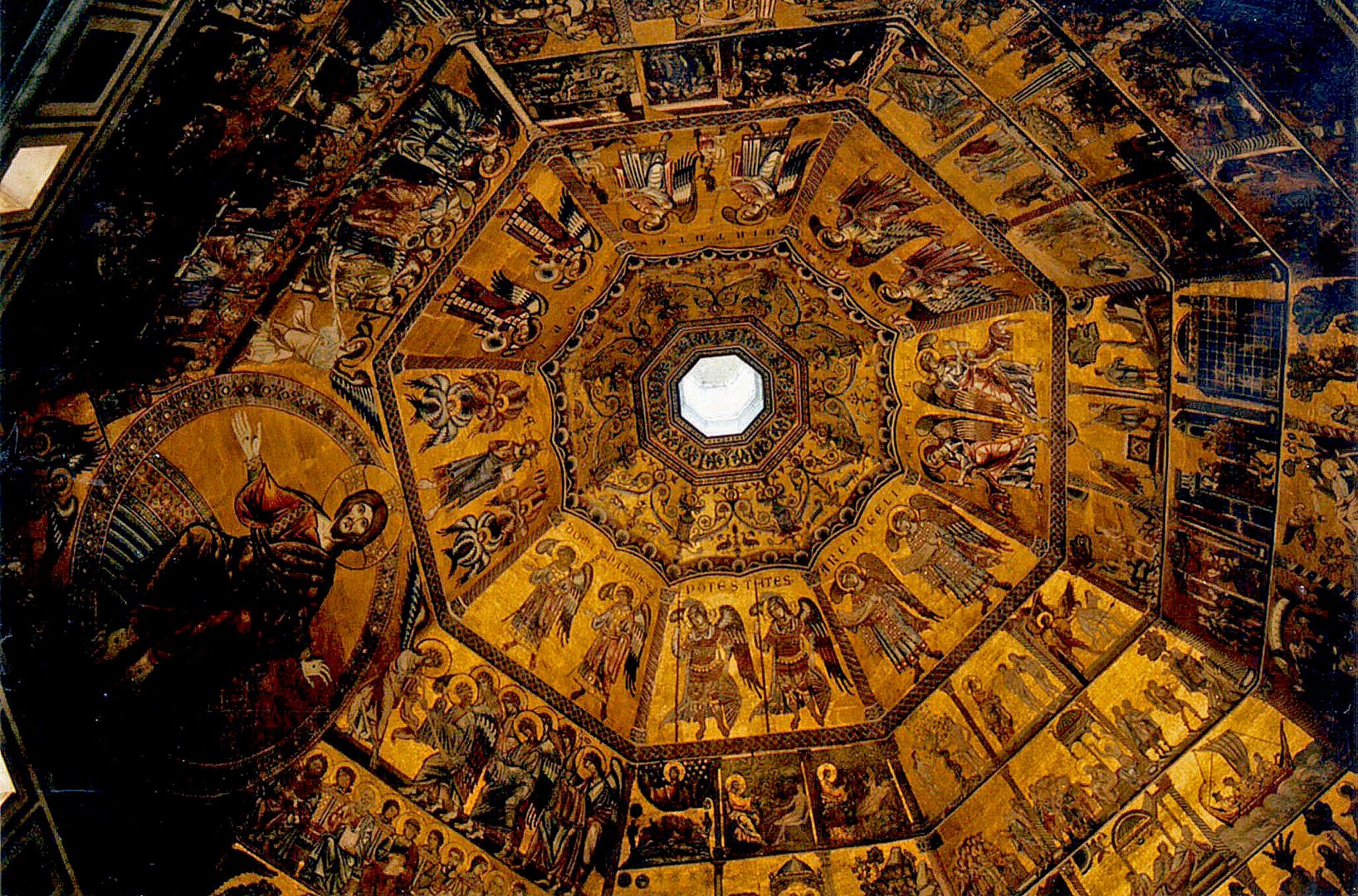Battistero di San Giovanni (Florence Baptistery) Ceiling
Battistero di San Giovanni (Florence Baptistery) Ceiling
The Florence Baptistery (Battistero di San Giovanni), also known as the Baptistry of Saint John, is a religious building in Florence, Italy, and has the status of a minor basilica. The octagonal baptistery stands in both the Piazza del Duomo and the Piazza di San Giovanni, across from Florence Cathedral and the Campanile di Giotto. The Baptistery is one of Florence’s most important religious buildings, dedicated to his patron saint, John the Baptist (whose feast is celebrated on 24 June). Raised on the foundations of a Roman building, it is a characteristic example of the Tuscan Romanesque style, dating according to some authorities from around the 11th century (it was consecrated in 1059); others believe that it is an early Christian building later remodelled. Intended for the liturgical function of baptism, in the 11th century it also acted as the city’s Cathedral. Such a large building was required because vast crowds attended the administration of baptism, which in those days took place only twice a year.
Its form is octagonal, and the exterior is sheathed in white marble and green Prato marble. The lower register has semi-pilasters, and the upper one polygonal columns supporting rounded arches. The third order, the roof and the lantern are typical of the 12th century; the west end is closed by a scarsella or altar recess, added in the 13th century. The powerful guild of Calimala (Cloth-Merchants) held the patronage of the Baptistery for centuries, and it was they who commissioned the magnificent gilded bronze doors, as well as many of the works of art inside. The earliest of the three doors is the one on the south side, modelled in 1330 and then cast by Andrea Pisano. It was set up in 1336 on the east side, and moved in 1452 to make way for Lorenzo Ghiberti’s ‘gates of Paradise’. The decoration of Andrea’s door consists of quatrefoil panels of Scenes from the life of St John the Baptist, with the Theological and Cardinal Virtues beneath. When the door was moved to south side it was provided with a bronze frame, made between 1452 and 1462 by Lorenzo Ghiberti’s son Vittorio. Lorenzo himself made the north door between 1403 and 1424, after he had won the famous competition of 1401, in which his submission was preferred to those of Brunelleschi, Jacopo della Quercia and other artists. The north door consists of twenty quatrefoils panels with scenes from the Life of Christ, the Four Evangelists and the Doctors of the Church. This scheme seems to have cramped Ghiberti’s talent for naturalistic representation, which however was given free rein in his great masterpiece, the third Baptistery door. In this one, called by Michelangelo ‘the gates of Paradise’, Ghiberti was able fully to express his gifts as a goldsmith and a sculptor, distributing in ten large panels some of the principal scenes from the Old Testament, from the Labours of Adam and Eve to the Meeting of Solomon and the Queen of Sheba. Commissioned by the Calimala in 1425, it was finally finished and installed in 1452.
The interior, filled with works of art and heavy with historical and religious associations, has geometrical patterns in bi-chromatic marble, alternating in the lower register with granite columns surmounted by gilded capitals, and with fluted marble pilasters. A gallery runs around the upper register, which supports the dome. The ancient font, demolished in 1576, was originally a large structure in the centre of the pavement, decorated with marble intarsia showing the Signs of the Zodiac and oriental geometrical motifs. Most extraordinary of all is the interior of the dome, entirely covered with mosaic showing the Angelic Hierarchies, Scenes from Genesis, Scenes from the life of Joseph the Patriarch, Scenes from the life of Christ, Scenes from the life of St. John the Baptist, and the Last Judgement. The mosaics in the apse are by the Franciscan Jacopo di Torrita (1255). Covering the inside of the Baptistery with mosaic was a difficult and costly undertaking. Work possibly began around 1270 and continued until the beginning of the following century; according to some authorities, Venetian craftsmen were employed, certainly assisted by important local artists who supplied the cartoons, such as Coppo di Marcovaldo (who was responsible for Hell), Meliore, the ‘Magdalene Master’, and Cimabue (to whom the earlier Scenes from the life of the Baptist are attributed).
Like all mediaeval religious buildings, the Baptistery contains tombs of prominent individuals. Outstanding among these is the tomb of the Anti-Pope John XXIII, who died in Florence in 1419. This is one of the earliest and most interesting wall-tombs in the renaissance manner, made between 1421 and 1427 by Donatello and Michelozzo. Donatello sculpted the figure of the dead prelate in gilded bronze, while Michelozzo was probably responsible for the Madonna and Child and the Theological Virtues.
http://www.museumsinflorence.com/musei/Baptistery_of_florence.html
http://en.wikipedia.org/wiki/Florence_Baptistery










Comentarios 0
Borrar comentario
Borrar comentario y respuestas